#Hitomi Okawa
Explore tagged Tumblr posts
Text
Mini Lolita Fashion History Lesson: MILK
Today, MILK is generally known as an 'otome' or 'girly' brand, and many of their modern items don't look like what modern lolita think of as lolita.

A recent MILK collection However, in the late 80s and early 90s, MILK was considered to be one of the quintessential Lolita brands.

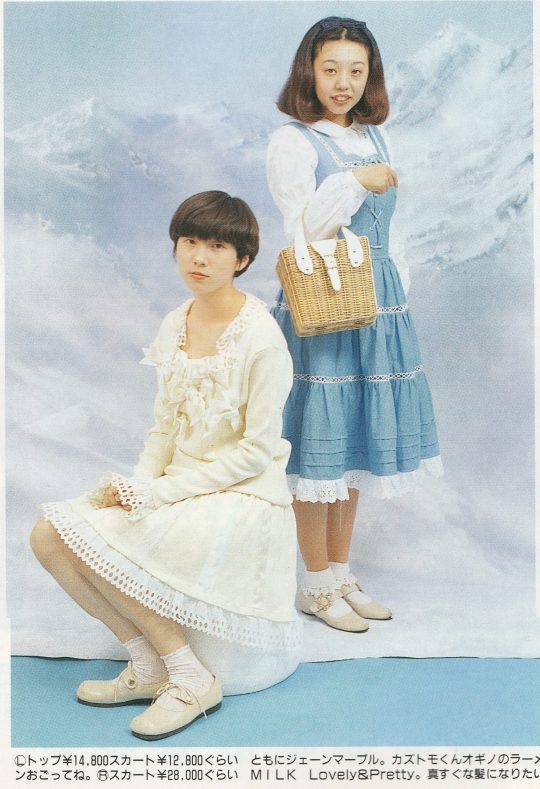
1990s lolita wearing MILK In a 1994 zipper interview about the history of lolita fashion the brand representative for MILK states "I think what is now called lolita fashion is the fashion that milk has been making for a long time."
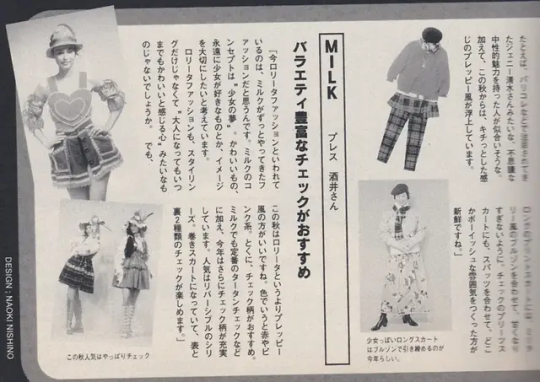
MILK was founded in 1970 by Hitomi Okawa (大川ひとみ). When Hitomi Okawa started as a designer there were not many DC brands yet and ready to wear fashion was really just starting to become more widespread in Japan. Okawa attended an art university in Kyoto because of a love of drawing that started in elementary school. She used to draw illustrations of girls and make things like paper dolls. At the age of 11, she drew many pictures of the same clothes and changed the patterns (polka dots, checks, flowers). She grew up the daughter of a doctor, in an affluent home where her mother would read magazines like Harper's Bazaar with 1950s and 1960s American fashion. She also looked at American fashion catalogs as a child, and cites this study of clothing in magazines and catalogs as her earliest sort of "studying" of fashion.
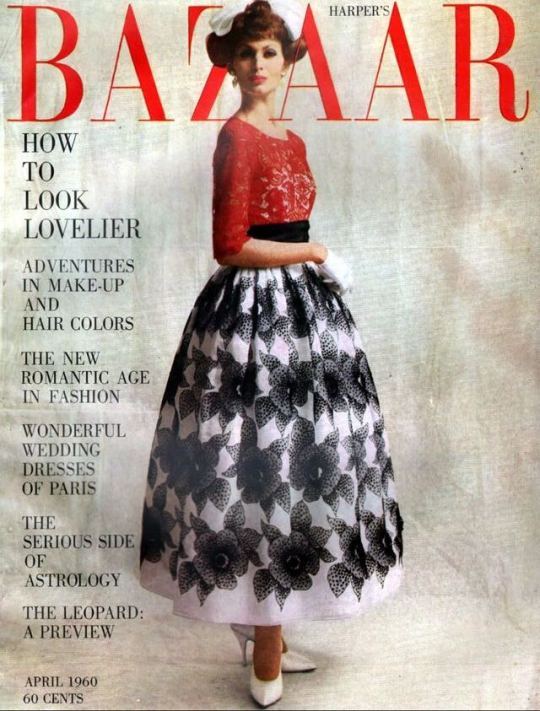
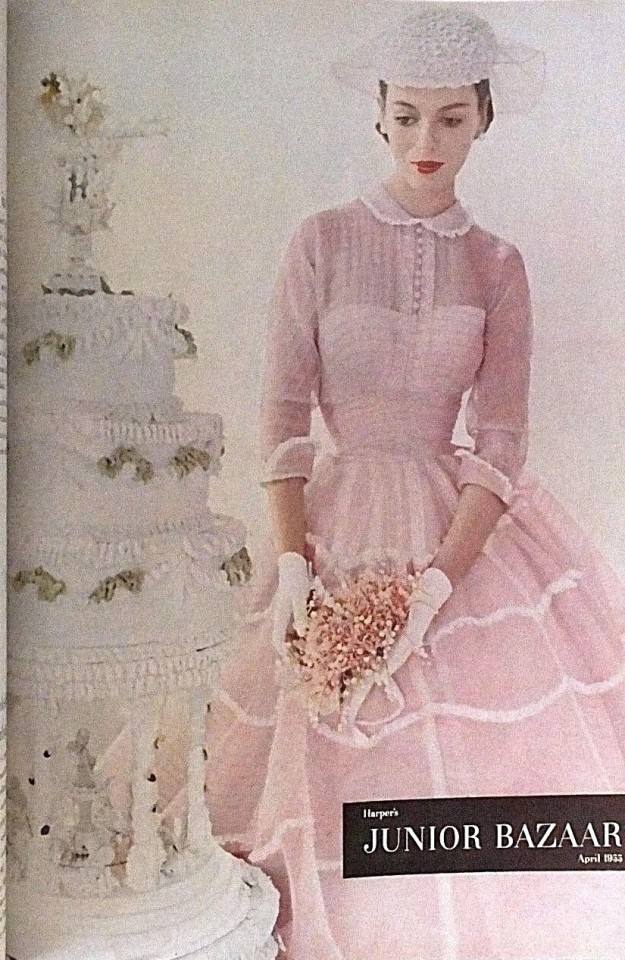
50s/60s Harper's Bazaar In addition to drawing inspiration from the 50s & 60s Harper's Bazaar & American clothing catalogs, she also drew inspiration from military uniforms and how they have custom buttons and custom fabric and details like that, as well as current trends in London and Tokyo as the brand continued to develop. When she started however, she says that she was the only one making this sort of cute girly clothing in Japan and she felt like she had to make it because no one else was making what she wanted to wear.
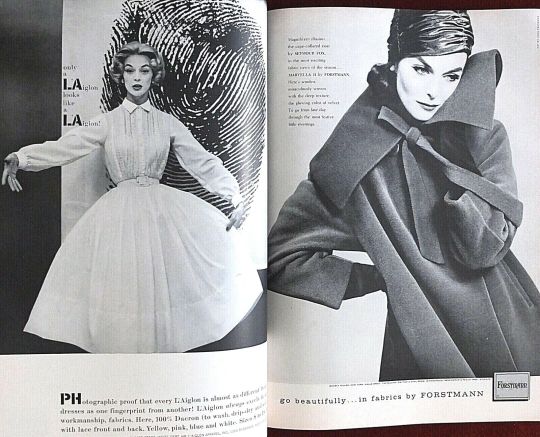
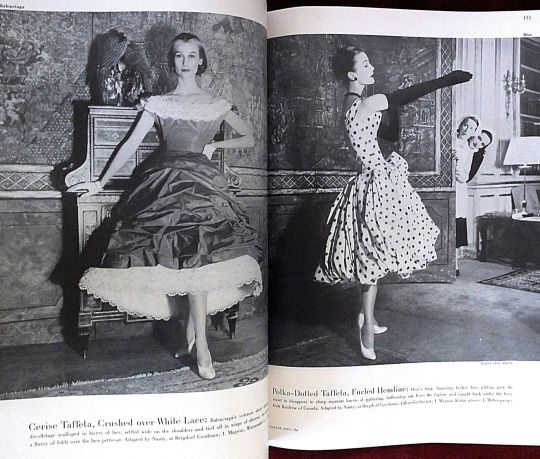
50s/60s Harper's Bazaar
After graduating from Seian College of Art and Design, Department of Design, she started MILK in Harajuku. She wanted to start in the coolest place possible, so she decided on Central Apartment.
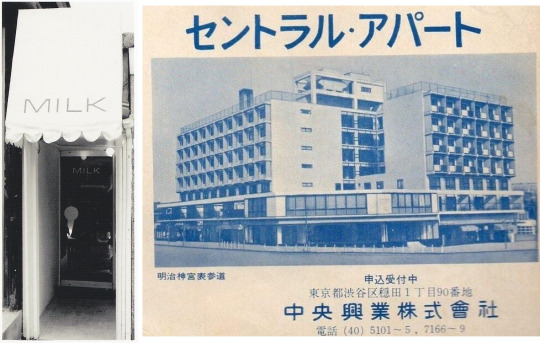
MILK Shop Front in the 70s, Central Apartment
She had come to Harajuku when she was either in High School or her first year of University and had stood in the middle of the pedestrian bridge right off Harajuku station, and she looked down at Omotesando and thought "Here is the coolest place, I want to be here!", and that's why she chose that location. The Bridge doesn't exist any more, it was torn down in 2011. She wasn't aware at the time that Central Apartment was a popular place for creators, she just thought that street was nice and that Central Apartment was modern and cool. In a 2021 interview she confessed that she sometimes still goes up to the pedestrian bridge on the Yoyogi Park side and looks at Omotesando, and when she does, she feels the same way she did when she was 20 years old.
Central Apartment (原宿セントラルアパート) was initially an apartment complex built in Harajuku in 1958 at the intersection of Meiji-dori. It was initially built for special international travelers like US military personnel. In the mid 1960s/early 1970s, the lower floors were converted into stores with offices in the upper apartment floors.
The Coffee shop Leon on the first floor was a popular spot with creative people. There were also shops like Mademoiselle Nonnon launched by designer Taro Aramaki which sold French style clothing and lots of horizontal stripes. Mademoiselle Nonnon is considered to be the source of the border (horizontal stripe) trend in Japan.

Initially, "MILK", was expensive and unrealistic for everyday wear, so it was mainly used as a stage costume for idols, however, people started wearing Milk as everyday clothing as time went on.
MILK also experimented with a Bridal line in the 70s as well.
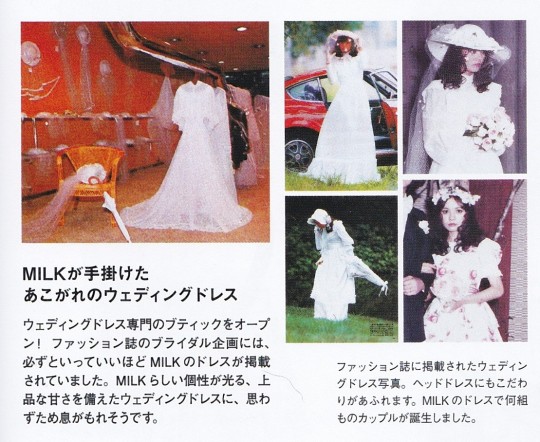
While their runway looks were generally a bit more loud than the way the pieces would have been worn in real life, you can see some prairie revival influence their early 70s items as well as some silhouettes in the '76 collection that are starting to look more lolita-esque.
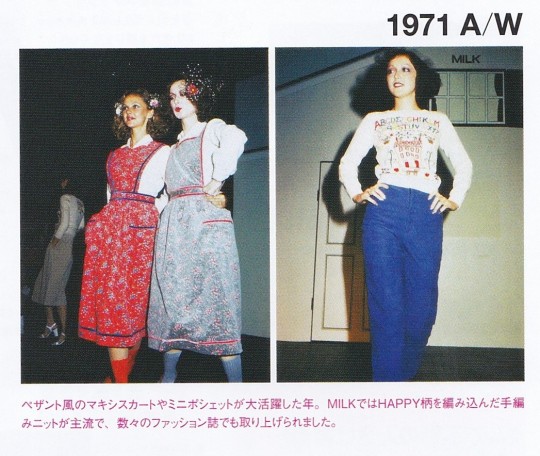
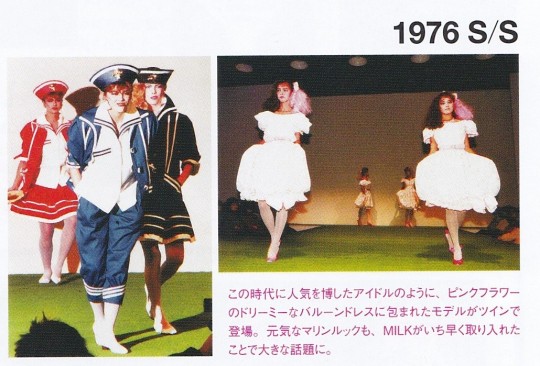
Here are a few runway examples from the 1980s, note the border print of a carousel in the 1988 collection and the knee length ruffled skirt in the 1982 one.
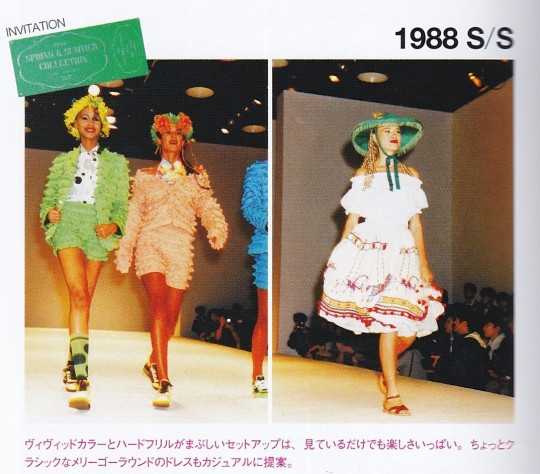
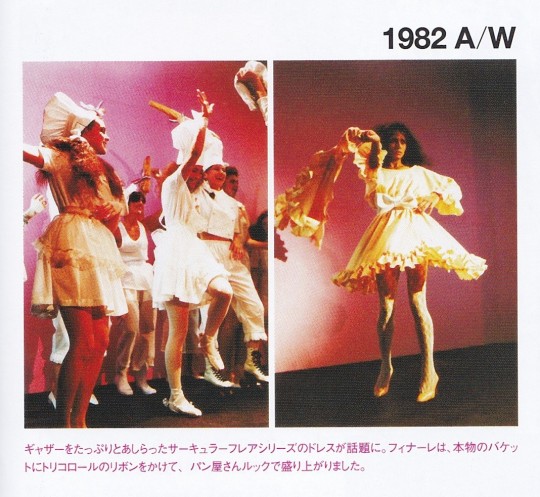
By the early 1990s, MILK was heavily featured in coordinates worn by young women who considered themselves lolita in magazines like Cutie and Zipper, and was also advertising in those magazines.
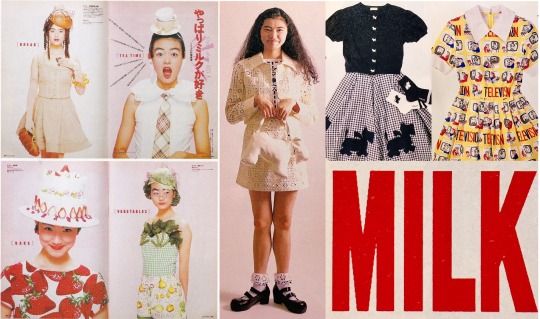
1990-1992 Cutie advertisements for MILK
Early 1990s looks from MILK were fairly consistent with what was on offer from similar shops like PRETTY and Shirley Temple.
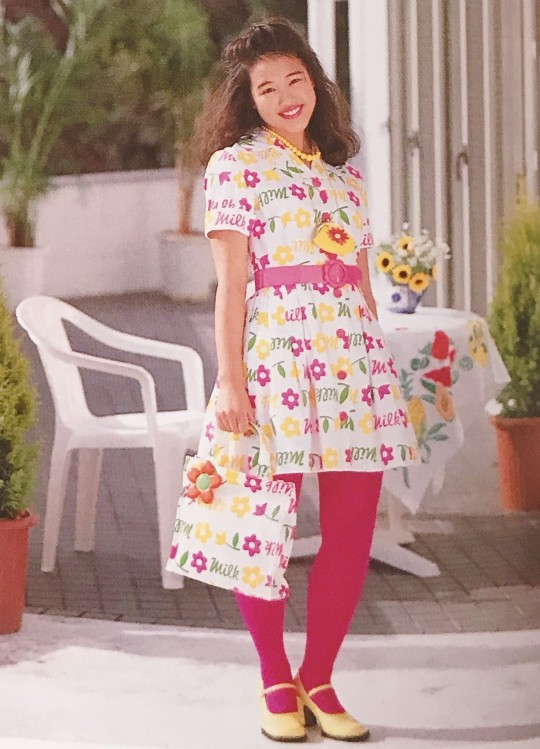
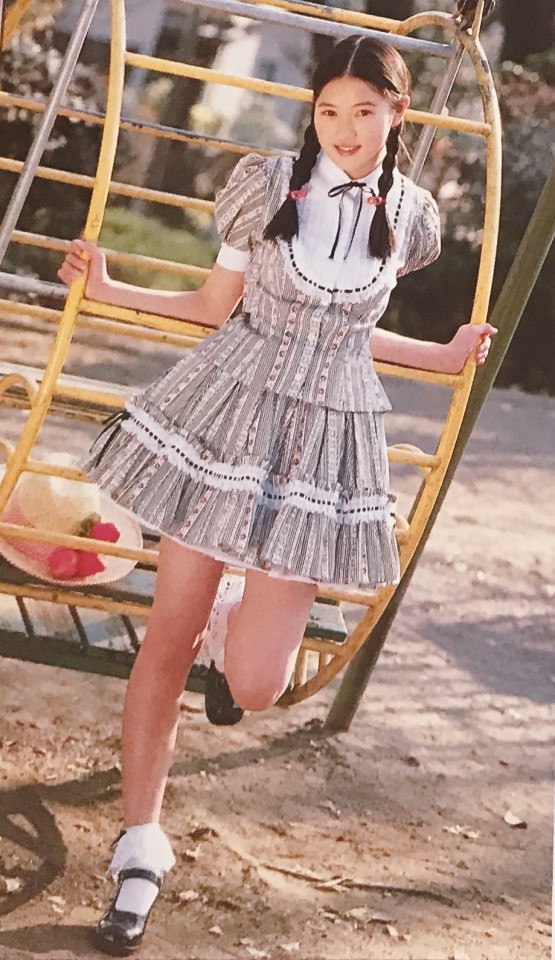
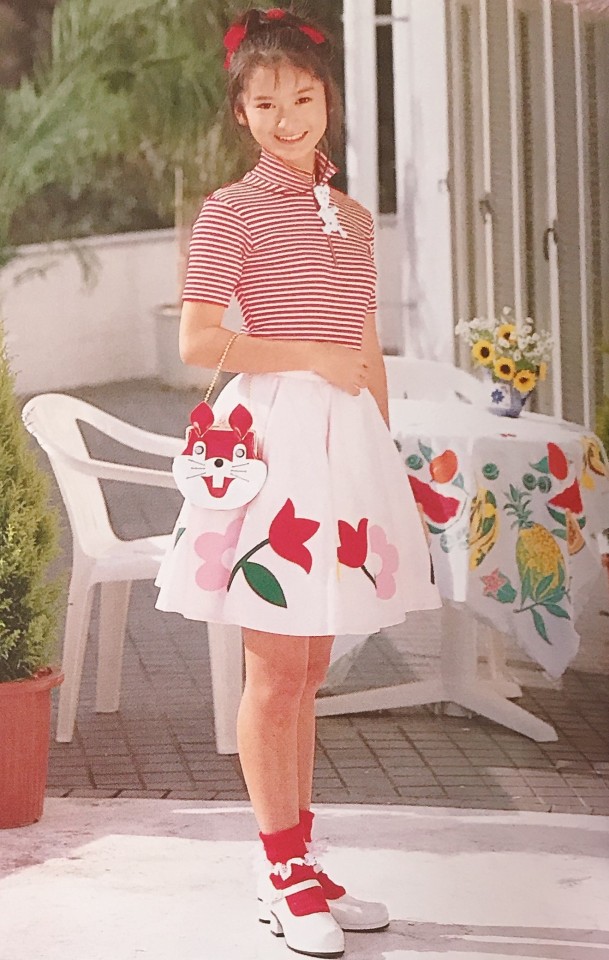


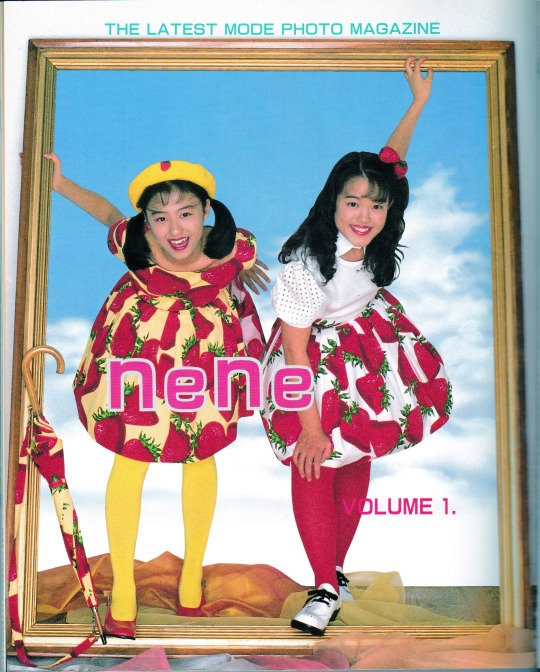
MILK Coordinates from Nene magazine, 1995
Speaking of Shirley Temple, the founder of Shirley Temple, Rei Yanagawa (柳川れい), worked as a designer for MILK before starting the Shirley Temple children's brand in 1974.
As time went on, lolita fashion started to diverge from the MILK style, while MILK followed their own design concept and look more at current trends in girly fashion. Today, some iconic MILK items like their heart purse are still frequently used in lolita fashion, however, it would be difficult to walk into MILK today and put together a coordinate that would read the same as one made from items at Angelic Pretty.
While goth and punk brands typically have no issue relating themselves to goth or punk fashion, brands popular with lolita have sometimes resisted self-describing themselves as lolita, most likely in an attempt to not alienate non lolita customers, due to lolita fashion having a mixed reputation. MILK, like many other Japanese brands, especially DC brands, maintains that they make MILK style, even though their influence on what we call lolita fashion today, is unmistakable.
Past Posts: Olive Girls
#MILK#Old School Lolita#Lolita Fashion History#Shirley Temple#90s Jfashion#80s Jfashion#70s Jfashion#Lolita History#Central Apartment#Hitomi Okawa#Mini Lolita History Lesson
347 notes
·
View notes
Photo
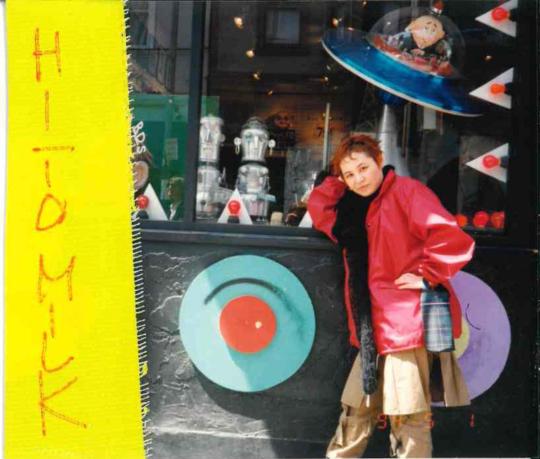
2 notes
·
View notes
Text
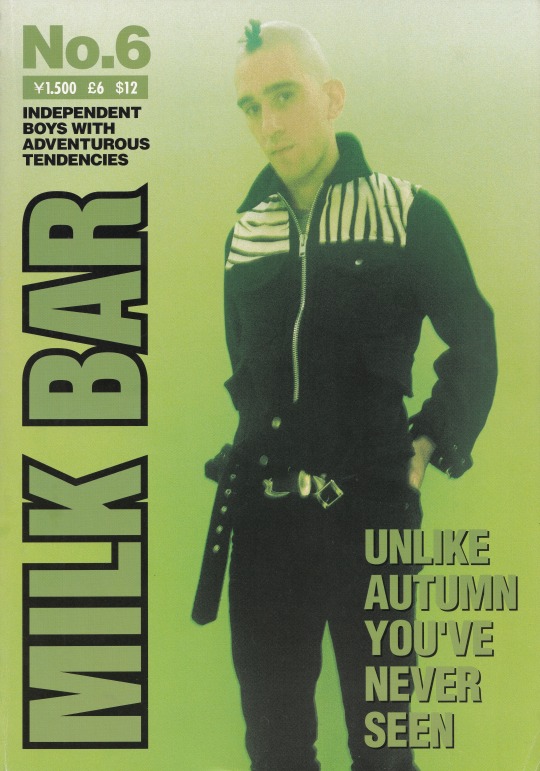
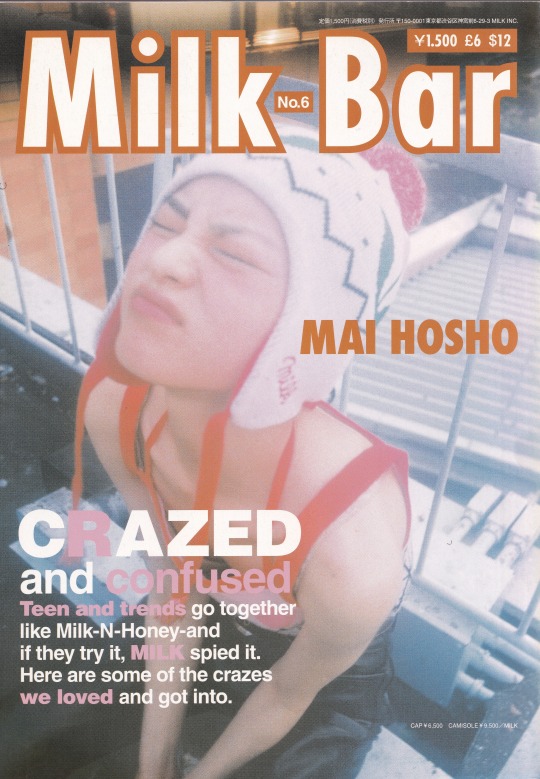
front + back of issue six of milk bar
a magazine that ran from 1996 to 2001, dedicated to showcasing the latest fashions of hitomi okawa's brand "milk."
photo: ryota atsumi
1998
26 notes
·
View notes
Link
In the brief history of street culture, Hitomi Yokoyama is one of its most prominent hidden figures. If Hiroshi Fujiwara is considered the de facto “godfather of Japanese streetwear,” Yokoyama is most definitely its godmother. A contemporary of UNDERCOVER founder Jun Takahashi and Tomoaki ���NIGO” Nagao — who would go on to establish A Bathing Ape and Human Made — Yokoyama was at the forefront of Tokyo’s Ura-Harajuku movement that gave rise to Japan’s cadre of covetable brands like WTAPS, Neighborhood, Bounty Hunter, and countless others.
As a teenager growing up in Tokyo’s Yotsuya neighborhood, Yokoyama became fixated with the British punk bands she saw on TV and heard on the radio. “I was listening to The Clash, Adam & The Ants, and The Sex Pistols,” she says. “The first thing in fashion I got really excited about was Malcolm McLaren and Vivienne Westwood’s clothing I saw Johnny Rotten wearing.”
It was through seminal Japanese magazines like Takarajima that she got put onto McLaren and Westwood’s Seditionaries clothing line and SEX shop in World’s End. She also discovered “Last Orgy,” an influential Takarajima column started by Hiroshi Fujiwara. It was basically a cheat sheet of what brands, bands, and trends were about to blow up.
But Yokoyama didn’t just read about what was cool — she lived it, too, exploring Tokyo’s underground nightlife at clubs like Picasso and Nabaron, which played everything from ska, rockabilly, and reggae to the hottest bands in London at the time. The scene got her close to Jun Takahashi and future Bounty Hunter founder Hikaru Iwanaga, who played in a tribute band called the Tokyo Sex Pistols, and NIGO, who sometimes stepped in as their drummer. Yokoyama remembers how the now-icons dressed at the time, recalling Takahashi as a would-be Johnny Rotten and Iwanaga as a stand-in for Sid Vicious.
“This kind of place was more like a culture school than just a club,” she says. It’s where she learned how to dress and met like-minded people who shared the same passions, like Vivienne Westwood and punk. “It was a real life social network in the days before the internet.”
NIGO and Takahashi had met at Tokyo’s prestigious Bunka Fashion College, the same institution that produced Yohji Yamamoto and Junya Watanabe. Yokoyama worked at a hair school in the neighborhood called Ciao Bambina, which doubled as a community hub for area youth, since their parents weren’t allowed in. NIGO got his hair cut there, and Yokoyama admits she used to steal a product called Rock Gel, a hard hair gel ideal for Takahashi’s avant-garde punk hairstyles.
At the same time, Takahashi and NIGO were becoming a dynamic duo in their own right. They had taken the reins of Fujiwara’s “Last Orgy” column and brought it to Popeye magazine (the newer, younger answer to Takarajima) under the moniker “Last Orgy 2.” It was clear they had the juice now, so under Fujiwara’s mentorship they turned their platform into a first-of-its-kind retail concept: NOWHERE.
Before that store opened, Yokoyama remembers the small network of streets as a neighborhood with hidden gems interspersed throughout. There was Hitomi Okawa’s MILK, Nobuhiko Kitamura’s Hysteric Glamour, and punk boutique A Store Robot, which Yokoyama frequented. But NOWHERE began the evolution of Harajuku’s backstreets into an in-the-know shopping destination. The shop launched both Takahashi’s UNDERCOVER and NIGO’s A Bathing Ape.
“Jun started making clothes on a domestic sewing machine, making one-off items. He was a genius at an early age,” remembers Yokoyama. “Then you had NIGO, who was a massive expert on vintage clothing and had great style.”
The Ura-Harajuku scene and the brands to emerge from it would expand from a small underground community to a huge global movement, and Yokoyama would play a crucial part in that transition when she moved to London in 1993.
“My plan was to study English and go to make up school,” she explains. “One day, I was walking down the street and I met a guy called Barnzley. He recognized my Seditionaries clothes and was very curious about my UNDERCOVER clothes.”
Fate made it so that one of the first people Yokoyama met in London was one of its most well-connected people. Simon “Barnzley” Armitage is a fixture of London’s club scene and its underground subculture. As a shop guy for Vivienne Westwood and Malcolm McLaren, he took advantage of the store’s screen printer to make bootleg Chanel T-shirts before getting into deconstructing clothes. He’s donned many hats and worked on numerous projects throughout the years, including co-founding the label A Child of the Jago with Joe Corre — Westwood and McLaren’s punk progeny.
Yokoyama’s Seditionaries fit caught his eye immediately, and they connected over a shared love of clothes, music, and punk culture. Yokoyama was still looking for a room, and Barnzley actually had an opening at his flat, recently vacated by Spanish artist Luciana Martinez de la Rosa.
“I think Hitomi was quite happy to move into a flat full of cool clothes, art, and records,” recalls Barnzley. “Maybe not so happy I kept her up all night with loud music, girls, insane pop stars, and messy graffiti artists.”
Yokoyama admits she didn’t get much sleep thanks to the loud music, but describes the London she found as “like Disneyland.” With Barnzley as her cultural sherpa, she rubbed shoulders with Joe Corre, Nellee Hooper of The Wild Bunch, Paul Cook of The Sex Pistols, Primal Scream’s Bobby Gillespie, and Paul Simonon of The Clash. Many of the figures she previously only read about, that seemed worlds away in the translated pages of Japanese glossies, now became face-to-face acquaintances.
“Everybody seemed to be a pop star, artist or model,” she says. “It was nonstop ’til 4 a.m. most nights.”
In addition to putting Yokoyama on to London’s hippest clubs and clothing stores, Barnzley also introduced her to Cuts, an underground hair salon that was pretty much the city’s answer to Tokyo’s Ciao Bambina. Founded by the late James Lebon, younger brother of fashion photographer Mark Lebon, he created a template for a new breed of alternative hairdressers. Inspired by the DIY ethos of punk, Cuts was the first in a new type of independent hairdressers whose multi-ethnic aesthetic chimed with that of Ray Petri’s wabi-sabi Buffalo style.
“It was a hub for street fashion as there were shoots for i-D and The Face. It was also where you’d find out information on clubs, clothes, and all that culture,” Yokoyama says. “Working there was more like a very fashionable club than a hairdresser. It was my introduction to fashionable London.”
International Stüssy Tribe member Michael Kopelman was also a Cuts regular. In 1989, he founded Gimme 5 as a distribution company, spreading the gospel of Japanese streetwear by introducing brands like Neighborhood, UNDERCOVER, visvim, BAPE, and Hiroshi Fujiwara’s GOODENOUGH into ahead-of-the-game boutiques like Hit and Run (later renamed The Hideout). By 1995, Kopelman and Yokoyama’s mutual appreciation had grown to the point where he felt comfortable enough offering her a job. “We were both into similar things from Japan. Nobody else in London was,” he says succinctly.
With no previous background in art (and never even having worked on a computer before), Yokoyama’s strong sensibilities informed what would become Gimme 5’s aesthetic. Inspired by everything from Eames chairs, old record sleeves, and comic books, she taught herself to use programs like Illustrator, eventually designing a Gimme 5 clothing logo cribbed from Jack Kirby’s Fantastic Four comics. Her work went on to impress her friends back in Japan, leading to graphic work for UNDERCOVER, A Bathing Ape, Real Mad Hectic, and Let It Ride as well as New York brands like aNYthing.
By the mid-2000s, Yokoyama received a major profile boost when she designed a purple and maroon Air Stab for Nike’s sought-after 2006 Air-U-Breathe pack. She was inspired by the lightness of the sneaker, as well as images of rabbits and cats jumping around in her head, leading to the striking graphic on the heel she describes as “paws with eyes.” She followed it up in 2008 with a mostly gray Air Max 90 Current created under Nike’s Co-Lab program for the Beijing Olympics.
Despite her impressive pedigree, Hitomi Yokoyama’s work seems largely swept under the rug in the story of streetwear. Perhaps that’s because she’s always gone under the pseudonym “HIT.” It was a conscious decision on her part, creating an air of mystery around this cryptic, Japanese designer in the vein of a SK8THING or SKOLOCT.
“I started working with all these men’s brands and they wanted to the put the designer’s name on the shirts,” she says. “There weren’t many females around at the time, and I was worried that people from that scene would not take me seriously if they knew I was female. So with the alias HIT, I would not be discriminated against; it’s genderless.”
Yokoyama’s most prolific collabs aren’t just with products, but people. Through her friendships in Tokyo and London, she helped foster long-lasting relationships, like linking Mo Wax impresario James Lavelle and NYC graffiti writer Stash with NIGO. She also became especially close with the late, legendary stylist Judy Blame, who was the inspiration for Dior’s Fall/Winter 2020 men’s collection. Yokoyama is in the final stages of her own Judy Blame tribute, a brand called Available Nowhere that uses Blame’s archive on a series of T-shirts, jackets, shirts, and scarves.
Whatever she’s doing, Hitomi Yokoyama is eternally grateful for the chances London gave her as a wide-eyed young woman from Tokyo. She admits that if things hadn’t worked out abroad, she’d have probably moved back to Tokyo and worked at a Shinjuku sushi restaurant. Now she wants to pay that kindness forward to the next generation.
“I hope to work with artists, designers, and interesting people who might be not well-known,” she says. “I want to help young people with lots of energy learn from old people with experience.”
Words: Andy Thomas
#undercover#james lavelle#nigo#a bathing ape#bathing ape#Hitomi Yokoyama#streetwear designers#women in streetwear#stash#aNYthing#real mad hectic#urbanwear blog
11 notes
·
View notes
Video
youtube
Killing Bites TV anime PV. Series premiere January 12th (Liden Films)
-Synopsis-
“People have been created that are human-animal hybrids, and powerful businesses bet on the outcome of their duels. College student Nomoto Yuuya's casual acquaintances ask him to drive them around to pick up girls one day, which he soon finds out means by force. The girl they kidnap is an animal-human hybrid named Hitomi, who slaughters all of them except Yuuya. Hitomi is a honey badger, which has been called the most fearless of all animals. Now Hitomi is assigned to stay with Yuuya, for his protection!”
-Staff-
Director: Nishikata Yasuto
Series Composition: Aoi Akashiro
Character Designer: Kazuo Watanabe
Music: Yasuharu Takanashi
OP Theme: fripSide
ED Theme: Kitsunetsuki
Animation Production: LIDEN FILMS
-Cast-
Sora Amamiya
Wataru Hatano
Maaya Uchida
Sumire Uesaka
Chinatsu Akasaki
Megumi Han
Yuu Asakawa
Takako Honda
Hidekatsu Shibata
Rikiya Koyama
Touru Okawa
Yuuichi Nakamura
Sayaka Harada
Ryoukan Koyanagi
Yuusuke Kobayashi
Taketora
Hiroyuki Yoshino
Katsuyuki Konishi
Yuuki Ono
Yoshino Nanjou
Junichi Suwabe
Source: http://killingbites-anime.com/
8 notes
·
View notes
Text
AKB48 Sokaku 2017
Announced on 2017.12.08 at AKB48 12th Anniversary theatre stage.
All kennins members cancelled, with the exception of Kashiwagi Yuki (Team NIII) and Okada Nana (STU).
All Team 8 members listed below are kennins in Team AKB4.
Team A: (22 people) Okabe Rin (new captain), Yokoyama Yui, Mukaichi Mion, Iriyama Anna, Oguri Yui, Tanikawa Hijiri, Kato Rena, Goto Moe, Chiba Eri, Chou Kurena, Hitomi Kotone, Hayasaka Tsumugi, Miyazaki Miho, Shinozaki Ayana, Shitao Miu, Okumoto Hinano, Nishikawa Rei, Shimoaoki Karen, Yoshida Karen, Taguchi Manaka (promoted), Maeda Ayaka (promoted), Suzuki Kurumi (promoted)
Team K: (25 people) Komiyama Haruka (new captain), Kojima Mako, Kuranoo Narumi, Tano Yuka, Minegishi Minami, Yumoto Ami, Muto Tomu, Oda Erina, Nakano Ikumi, Fujita Nana, Yokoyama Yui (8) Mogi Shinobu, Ichikawa Manami, Yokomichi Yuri, Taniguchi Moka, Hashimoto Haruna, Shimoguchi Hinana, Nozawa Rena, Harumoto Yuki, Hidaritomo Ayaka, Terada Misaki, Muto Orin (promoted), Yasuda Kana (promoted)
Team B: (25 people) Takahashi Juri (new captain), Kubo Satone, Kashiwagi Yuki, Fukuoka Seina, Taniguchi Megu, Honda Hitomi, Yoshikawa Nanase, Hiwatashi Yui, Oya Shizuka, Sato Akari, Sasaki Yukari, Nakanishi Chiyori, Yamamoto Ruka, Kawahara Misaki, Iwatate Saho, Yamabe Ayu, Takita Kayoko, Hattori Yuna, Shimizu Maria, Kitazawa Saki, Sato Shiori, Takeuchi Miyu, Kojima Natsuki, Ota Nao, Okuhara Hinako
Team 4: (25 people) Murayama Yuiri (new captain), Okada Nana, Sakaguchi Nagisa, Nagano Serika, Kawamoto Saya, Sato Nanami, Utada Hatsuka, Onishi Momoka, Omori Miyu, Gyouten Yurina, Tatsuya Makiho, Sato Kiara, Takahashi Ayane, Hama Sayuna, Ma Chia Ling, Okawa Rio, Hirano Hikaru, Noda Hinano, Miyazato Rira, Takaoka Kaoru, Takahashi Sayaka, Yamauchi Mizuki (promoted), Asai Nanami (promoted), Inagaki Kaori (promoted), Taya Misaki (promoted)
Team Kenkyuusei: (9 people) Honma Mai, Harima Nanami, Yamane Suzuha, Michieda Saki, Umemoto Izumi, Shoji Nagisa, Kurosu Haruka, Nagatomo Ayami, Sato Minami
3 notes
·
View notes
Text
Super Bomberman R: Character Info / JPN Voice Acting Credits (Dastardly Bombers + Buggler)
Firstly, official character descriptions have been released on the websites in both English and Japanese! Aside from Pretty Bomber now being Sexy Bomber in Japanese and Karaoke Bomber in English, the text is pretty much the same, aside from some slight differences:
Red’s JPN description specifically calls him a “hot-blooded idiot” (熱血バカ), whereas his ENG description is a little nicer about it.
Green’s JPN description refers to him as the team “mascot,” as opposed to being the favorite little brother.
Aqua is “Mizubon” (水ボン), which more literally means something like “Water Bomber” but probably is actually just a shortening of 水色 (mizuiro), “light blue.”
More interesting (at least in my opinion, but I’m sure no one cares about that) are the Japanese voice-acting credits for Buggler and the Dastardlies. Which apparently were actually in the JPN video description on YouTube, along with the credits for the bombersiblings, s-sob... It’s too early to be alive.
BUGGLER: Kotaro Nakamura (JPN Wikipedia) MAGNET: Tetsuya Yanagihara GOLEM: Yoshiyuki Hirai PHANTOM: Hozumi Gouda PLASMA: Yuuto Uemura KARASEXY: Hitomi Harada
Nakamura is the new voice of Dr. Eggman since the passing of Chikao Ohtsuka. Yanagihara and Hirai -- who are usually a package deal, rarely voice-acting solo -- played Gangu and Bongo from Bomberman Jetters; their credits here also mention the comedy act they’ve done together since 1994, America Zarigani. Gouda played Naitori from Bomberman Jetters as well.
For reference, the Japanese VAs for the bombersiblings, plus the opening cutscene in English and Japanese, can be found here.
WHITE: Keisuke Kawamoto Koumoto (JPN Wikipedia) BLACK: Shunsuke Takeuchi BLUE: Genki Okawa RED: Yuuma Uchida YELLOW: Yuuki Yonai (JPN Wikipedia) PINK: Mikako Komatsu AQUA: Minami Takahashi GREEN: Ayumu Murase
TL;DR all our Dr. Eggular jokes were eerily on point and I want comedy hijinks with Magnet and Golem.
4 notes
·
View notes
Photo
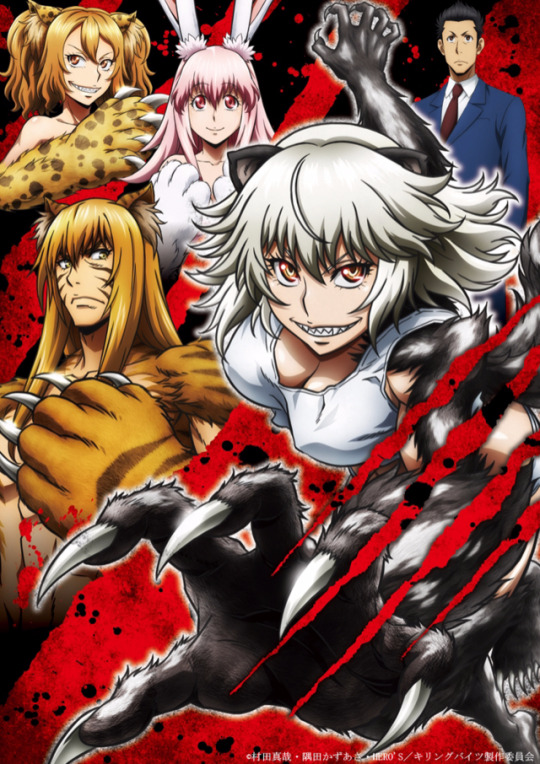
Killing Bites TV anime new key visual and additional cast revealed. Series premiere January 12th (Liden Films)
-Synopsis-
“People have been created that are human-animal hybrids, and powerful businesses bet on the outcome of their duels. College student Nomoto Yuuya's casual acquaintances ask him to drive them around to pick up girls one day, which he soon finds out means by force. The girl they kidnap is an animal-human hybrid named Hitomi, who slaughters all of them except Yuuya. Hitomi is a honey badger, which has been called the most fearless of all animals. Now Hitomi is assigned to stay with Yuuya, for his protection!”
-Staff-
Director: Nishikata Yasuto
Series Composition: Aoi Akashiro
Character Designer: Kazuo Watanabe
Music: Yasuharu Takanashi
OP Theme: fripSide
ED Theme: Kitsunetsuki
Animation Production: LIDEN FILMS
-Cast-
Sora Amamiya
Wataru Hatano
Maaya Uchida
Sumire Uesaka
Chinatsu Akasaki
Megumi Han
Yuu Asakawa
Takako Honda
Hidekatsu Shibata
Rikiya Koyama
Touru Okawa
Yuuichi Nakamura
Sayaka Harada
Ryoukan Koyanagi
Yuusuke Kobayashi
Taketora
Hiroyuki Yoshino
Katsuyuki Konishi
Yuuki Ono
Yoshino Nanjou
Junichi Suwabe
Source: http://killingbites-anime.com/
4 notes
·
View notes